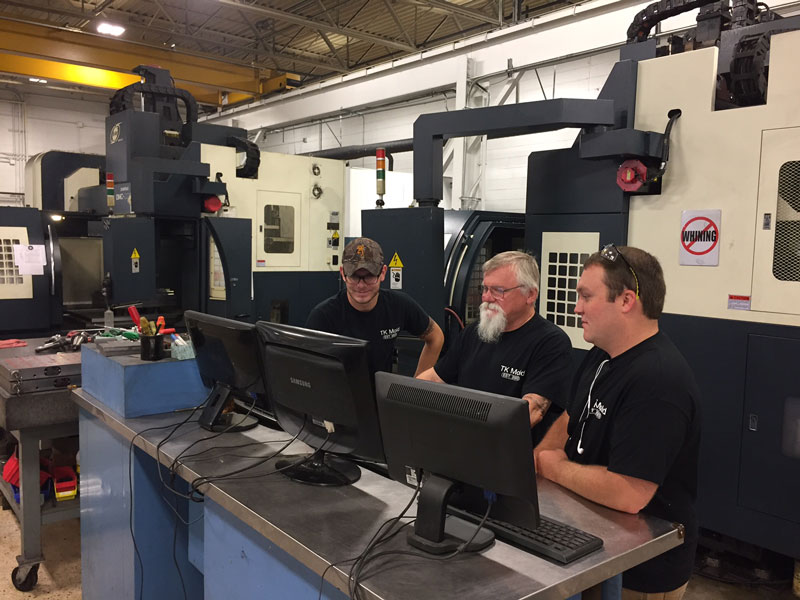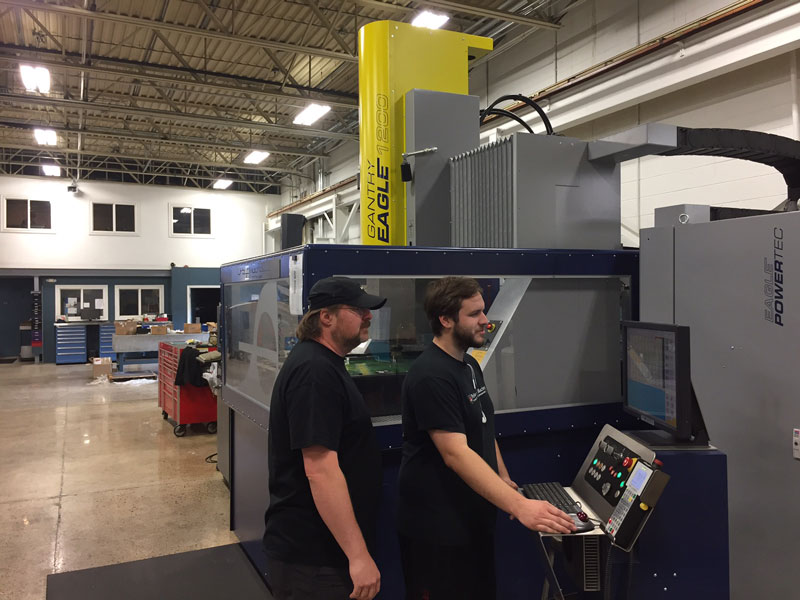by Dianna Brodine, managing editor
The American Mold Builder
Conversations in the moldmaking industry often revolve around recruiting the younger generation to the workforce, but little is said about keeping those employees once they’re through the door.
Tom Barr, president and owner of TK Mold & Engineering in Romeo, Michigan, wants to change the conversation. With more than half of his workforce in the 22- to 25-year-old age range, Barr has focused on showing his younger employees a defined career path.
“When you have young people in your shop, you become a coach,” he said. “You coach them through the job expectations, but you also show them what’s possible and get them excited about it.”
Building from the ground up
TK Mold opened its doors in 2003, and today the company’s focus is in building production and prototype molds from 85 tons to 1,000 tons. Two injection molding machines have been added for testing out molds, and – with a location in the Detroit area – TK Mold has a strong background in the automotive industry.
Barr has built a family-oriented business, because that’s what he knows. “I’m a third-generation mold builder,” he explained. “My grandfather was the owner of Corver Engineering and, when my dad and uncles took it over, I worked for them.”
From shop floor to the office and then back to the floor as a supervisor, Barr learned the business from the ground up, attending apprenticeship school and journeyman school while he worked, after a short stint at a traditional four-year university. “What’s interesting,” he said, “is it’s the same thing I see with the kids I have working at TK Mold. Many of the apprentices tried a four-year university and found it wasn’t for them, so now they’re looking for new opportunities.”
TK Mold (named after Tom and his wife, Krista) gave Barr the chance to create that opportunity. “I always wanted to start my own company, and I felt I had an entrepreneurial spirit,” he explained. “When I had the chance to chase my dream, my wife and I went for it.”
Barr purchased the assets of a moldmaking shop that was going out of business and assembled a strong base of employees – a core group of people he knew in the industry. But, he knew the older generation needed to start working on the younger one, and he had an idea of where to look.
“Not everyone wants book-based learning,” Barr said. “The kids who love technology want hands-on learning.”
Replacing a generation of lost workers
At TK Mold, a stunning age and experience gap exists. Of the 21 employees, 11 are in their early 20s and have less than three years of industry experience. Ten employees are over the age of 46, with anywhere from 25 to 50 years of experience in mold building. “There’s an entire generation of lost manufacturing and skilled tradespeople,” explained Barr. “For all of those years, people were being told not to go into manufacturing. Instead, they were funneled into universities – but that’s not the right choice for everyone.”
After Barr opened TK Mold, he eventually lost a few employees as they moved on to different careers. He decided to fill the open jobs with younger people he could train himself, teaching them from the beginning. “I looked around, and everyone in the shop was my age or older,” he said. “I still have a long way to go in my career – I hope I have another 15 years of valuable work in this trade. But, none of us were getting any younger, so I decided to try to find the newer generation and train them in the technologies.”
Barr knew communication would be the key to retaining the next generation of employees and keeping them excited about a career path in mold building. “When I started in the 1980s, there were always people in front of you with just a little more experience, so you had to wait your turn,” he explained. “But with the lost generation in manufacturing, these younger guys are coming in with a significant age gap, and there are opportunities to learn much faster than I learned. Back in the day, no one talked to me about being a CNC machinist or a designer or a tooling engineer. Today, those jobs aren’t far off for kids just starting out.”

Communicating a path toward advancement
A series of conversations and performance reviews sets the tone for younger employees at TK Mold, beginning during the interview process. “I try to explain my career path and the path of a lot of guys I worked with through the years,” he said. “And then, I show them how it could be different. I show them where they can end up financially and talk about potential job titles in five or 10 years.”
Once employees come on board, Barr reviews individual performance after 90 days, 180 days and at the one-year employment anniversary. Each review includes a discussion about improvements to be made, interest in various areas in the shop and an hourly rate increase.
“When an employee has been here for 90 days, we ask them some questions,” explained Barr. “What do you think? What do you like? Where are the areas you’re interested in? Then I talk about what the employee needs to learn to get to that position, and what’s possible even beyond that. Sometimes, I put my ‘dad’ hat on and show them the hours they’ll be working and the money they’ll be earning if they follow a path.”
After a year of employment, Barr invests in his staff by giving each apprentice a set of tools or a tool box, depending on what that employee needs. “It’s another way of helping them feel invested,” he said. “They have a basic set of tools that will serve them in their career.”
Barr said, “These kids need to have goals and aspirations when they go to work in the morning. And, if you look at the age group in my shop, you’ll see kids who have been around a little bit – they aren’t right out of high school. They might have serious relationships, and they’re a little more mature. They’re looking for a career now.
“If no one paints the goal for you, you don’t know what’s available,” he continued. “If you communicate and show them what’s possible, they become part of the team.”
Rewards are visible for both generations
Merging generations can be tricky, but creating an environment where everyone feels like part of the family goes a long way toward alleviating conflict. Barr has an eye on the culture of his shop.
“We have a more relaxed atmosphere in the shop than when I started,” he explained. “I laugh about that. It’s not quite Google here, but we do have a flexible start time – any time from 6 a.m. to 7 a.m. The employees have to get their scheduled hours in, but we give a window of time to try to be fair about it.”
To build the feel of family, contests are held around events such as the Kentucky Derby, March Madness or the Super Bowl, and Barr buys bagels for the employees on Fridays. His wife bakes birthday cakes and cupcakes for everyone, too. “We take any opportunity to build camaraderie, he said. “We’re lucky as a smaller shop, we can do that sort of stuff. It makes everyone feel like they’re part of the family and the team.”
TK Mold also allows employees to listen to music via wireless Bluetooth headphones, even though Barr acknowledges cellphone usage can be an issue. “If I see them with their phones out, I remind them to keep on the job,” he explained, “and, the work gets done. It’s another point in favor of communication – I’ve had to learn to listen to what they want and balance it with what the shop needs. But, I need to listen, because there’s nothing worse than feeling as if you’re not part of the team.”
Barr also takes the TK Mold apprentices to tradeshows, supplier open houses and demo days. “This way, they can see the new technology for themselves,” he said. “We need to expose them to the technology so they see where the trade is going.”
The communication and support doesn’t end with the younger generation of employees, however. Barr invests equal time in ensuring the journeyman moldmakers at TK Mold understand the goal. “I have communicated the vision of what it will be like if we do not train and help the next generation of moldmakers,” said Barr.
“Some days can be challenging for my experienced moldmakers but, for the most part, it’s very rewarding for them to work with the apprentices.”
A journeyman is assigned to work with each younger, newer team member to train them on the fundamentals of the equipment. The journeyman moldmaker who has been closest in working with the employee also is invited to the reviews. “It gives them an investment in the process, too, and lets them be heard,” said Barr.
“The journeymen are at a different point in their lives, so when they’ve done their jobs well in training the younger kids, those younger employees can fill a role by taking extra shifts or extra hours,” said Barr.

Creating a strong future for TK Mold
For Barr, the goal is simple: to create a work force that will allow TK Mold to be around for years to come.
“I’m 52, and I can see myself being involved in the business for another 15-20 years,” he said. “I would like to improve the culture around here with the younger workforce to make sure we’re here for the long haul.”
And, Barr pointed out, mold building isn’t the only industry struggling with a generational knowledge gap: “Our customers know about it – they’re having the same problems in their own companies. So, I talk to customers, and I tell them that we’re taking a little hit on the training now, but we’re going to be around for a long time. We’re making an investment, with the goal of remaining a vibrant company 15 years from now. We will still be serving their companies when some of our competitors are gone.”
Barr is passionate about the trade, and he wants his employees to see what’s possible. “Unless you know someone in moldmaking, you wouldn’t have any idea about the potential opportunities,” he explained, “so I want to paint a picture of what’s possible for them. But, there are benefits for TK Mold, too, because we also know that the trade is technology driven. The younger generation will embrace robotics and the newest technologies in EDM or CNC machining, and they will be the ones introducing it to the shop floor.”
In the end, Barr seems a bit envious at the future his younger employees will experience. “I see the apprentices doing tasks that my generation would never have had a chance to do that early in our careers. The opportunities in the industry were slower, back in the day,” he said. “Today, I want to show them how fast it’s going to happen.”


